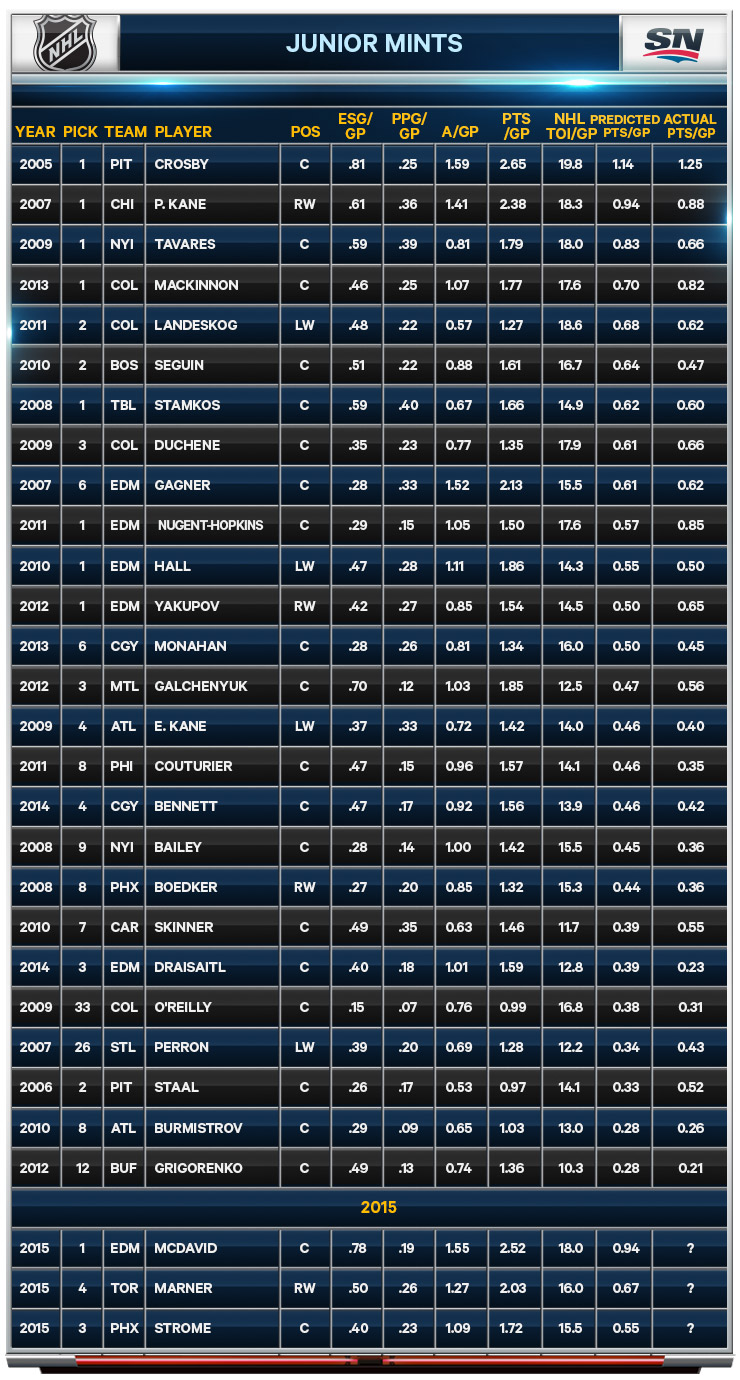Everyone who follows hockey knows of Connor McDavid as The Next One. The presumptive first overall will be heading to Edmonton after the 2015 NHL Draft. He will represent yet another great hope for the franchise representing the City of Champions as it creeps back to what it was in its glory days.
What doesn’t remain clear to many, though, is how quickly his impact will be felt on the franchise and the league, or what exactly that impact is likely to be. Fortunately we have some prior history to work with when it comes to predicting what’s next for Next Ones.
NHL Draft Coverage: | Broadcast Schedule
NHL Draft Tracker | Profiles on Top Prospects
New Sportsnet app: iTunes | Google Play
Sidney Crosby joined the Penguins at 18 and posted 102 points in 81 games. By his second year was leading the NHL in scoring with 120 points as a 19-year-old, earning his first Art Ross Trophy, being named a First Team NHL All-Star, winning the Hart Trophy as league MVP and the Lester B. Pearson Award (now the Ted Lindsay Award) as most outstanding player.
In his third season, he led the playoffs in scoring but was denied a Stanley Cup at 20 by the Red Wings juggernaut. He had to wait until Year 4 for his first—and so far only—Stanley Cup win. Since then he’s won a Maurice Richard Trophy for leading the NHL in goals, two more Pearsons, another Hart and another Art Ross. He’s also been a First Team NHL All-Star on two more occasions, and he’s probably the most recognizable face on the planet when it comes to hockey.
Crosby is the measuring stick by which we will inevitably assess McDavid. Similarly to how we compared and contrasted Nathan MacKinnon, Ryan Nugent-Hopkins, Taylor Hall, John Tavares, Tyler Seguin and any other top talent to make his way through the CHL ranks.
That being said, it helps when trying to predict outcomes to use all of the measurements available for the sake of comparison.
When examining how performance translates from prior leagues to the NHL, the current prevailing method revolves around league equivalencies. Basically, assessing the what proportion of prior output follows skaters when they move up to the NHL. Using the average performance of skaters who have made the jump in the past, a league equivalency rate is arrived at and applied to all skaters.
The problem with this method is it treats all skaters as equal by applying the same equivalency rate for their given league to their production. While it does a good job of assessing the relative strength of different leagues, it doesn’t do a particularly good job of assessing what to expect from a given player based on his talent level or expected usage in the NHL.
Since Crosby was selected in 2005, 25 other forwards have been taken near the top of the draft and made the leap from the CHL to the NHL the next season. By exploring the results of this more select cohort we get a better sense of how elite players will perform when making the jump at an early age.
We can also factor in the fact that different players will be given different opportunities. Crosby averaged 19-plus minutes per game at 18, while Mikhail Grigorenko played around 10 minutes per game for Buffalo his rookie season.
Using draft year production rates (both regular season and playoffs) and their time on ice as NHL rookies, we can use multivariate regression to derive a model that projects expected scoring rates for CHL forwards who are likely to end up in the NHL next season.
The table of relevant input data is provided below along with their actual time-on-ice per game in the NHL, their projected rookie season NHL points per game, and their actual NHL points per game.

While the model obviously isn’t an exact match, the correlation between the predicted production and actual production is quite high, showing a 50 percent improvement in accuracy over the values predicted using the more simplistic NHL to CHL equivalency model.
If we assume McDavid is likely to get every opportunity to perform once he gets to the NHL, we can expect to see him playing as many as 18 minutes nightly. At that number, the model projects him to produce 0.94 points per game (ppg), or 77 points in a full 82-game season.
If he were to approach or exceed that mark, he would be the most productive CHLer to enter the NHL since Sidney Crosby—which is essentially what most scouts and analysts are predicting, his model just further supports that outlook.
We can use the same model for Mitch Marner of London and McDavid’s Erie teammate Dylan Strome. Making some educated guesses about where their ice time might fall if they played a regular shift in the NHL next season, Marner projects as a 0.67 ppg player and Strome as a 0.55.
Those numbers would translate to production of 55 and 45 points in 82 games. Nothing to scoff at from an 18 year old. Alex Galchenyuk and Jeff Skinner both produced around 0.55 ppg in their rookie seasons, while Matt Duchene and John Tavares both ended up around the 0.67 mark.
The top-end offensive talent in this draft is at the extreme high end and goes deeper than McDavid and Jack Eichel. But no matter how we slice and dice the numbers, all signs point to McDavid being the generational talent of this year’s cohort, comparable to some of the best skaters the NHL has ever seen.
